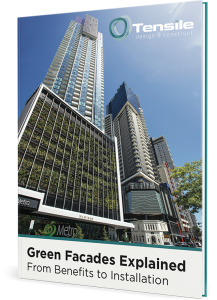Stainless Steel Webnet Mesh for Bridge Safety and Aesthetics
Stainless steel Webnet mesh offers tremendous scope for improving safety on pedestrian and cyclist bridges.
But it doesn’t have to be only functional – Webnet can also enhance the aesthetics of bridges.
Here’s how.
Footbridge safety
Footbridge barriers must comply with the Bridge Code (AS5100) and local guidelines.
A compliant barrier should prevent falling, climbing and jumping from the bridge, in turn reducing the risk of accidents and preventing or delaying suicides.
In some areas, local authorities will mandate that a bridge has an anti-throw screen installed to prevent throwing or dropping of objects – acts which can result in accidents, injuries or deaths. Whether or not a bridge requires an anti-throw screen depends on a variety of factors. These include past history of occurrences, whether the bridge is positioned over a busy highway in a built-up area, or if there are loose rocks nearby.
Greater fall protection and anti-throw prevention can be achieved by installing solid parapet walls made from concrete, timber or perspex, or by completely enclosing the bridge. However, this approach can impact on aesthetics. It can also cause other problems such as blocking surrounding views, creating a wind tunnel effect and applying additional heavy structural load to the bridge.

Bridge aesthetics
When it comes to creating a footbridge barrier, its appearance is an important consideration on top of safety aspects. The designers of an aesthetically pleasing footbridge would likely be not too happy about a heavy or cumbersome barrier being applied to their creation!
Webnet mesh provides a viable and cost-effective alternative to heavy barrier materials. Webnet’s light profile and transparency allow for clear views and an elegant appearance, while being compliant and avoiding additional structural load.
Solid material barriers can also be unsuitable for bridges that do not adhere to straight lines. Webnet however is an extremely malleable material, making it highly adaptable to the geometric shapes and curves of structures.
When it comes to climbability, there are no specific guidelines for mesh barriers. However, the general industry standard to prevent footholds is to use mesh with aperture openings of 40mm or less.
Stainless steel Webnet mesh barrier projects
- Elizabeth Quay footbridge, Perth – a 110m-long S-curved pedestrian and cyclists bridge that crosses over the Swan River. The mesh for the bridge’s barrier was sized into eight panels that were matched to the bridge’s curves, creating a barrier that provides safety, while being light in appearance.
- Albert Cotter pedestrian bridge, Sydney – this 6m-wide walkway crosses over the busy Anzac Parade at Moore Park. With its curves and spirals the bridge, needed a flexible throw screen to match its geometry. Webnet was chosen for this reason, resulting in a transparent and elegant barrier that follows along the bridge’s shapes.
- Lachlan’s Line footbridge, Sydney – this bright blue helical-shaped bridge is not just a bridge but also a sculptural landmark. 1.5mm Webnet was used for the bridge’s anti-throw screens, with each panel being uniquely designed and shaped prior to installation.
If you’d like to know more about this or to discuss your bridge project idea, contact us.






































